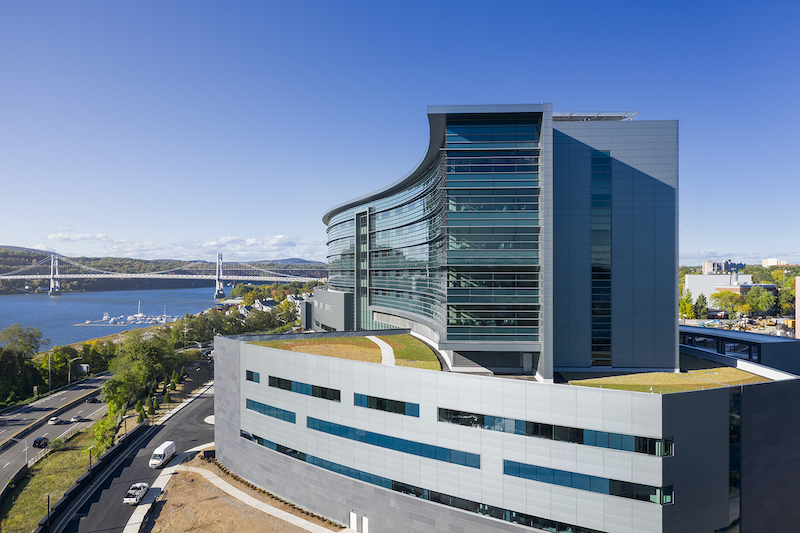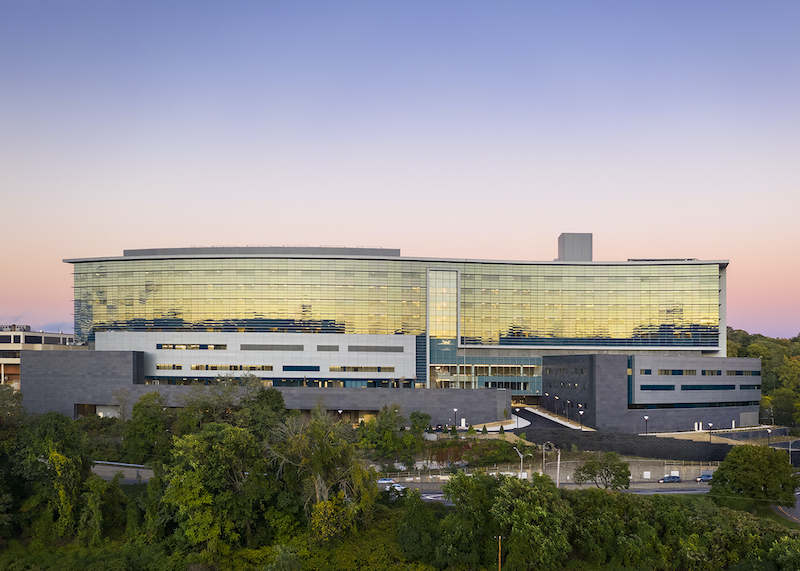Even as healthcare systems around the country have struggled financially during the coronavirus pandemic, big-ticket projects are getting built to meet expanding patient needs, especially in growing markets.
On January 11, Nuvance Health opened its $545 million, eight-level Patient Pavilion addition to Vassar Brothers Medical Center in Poughkeepsie, N.Y. This is the largest single construction project in this city’s history.
“It’s important to remember this project represents the most significant transformation of Vassar Brothers since its inception in 1887,” said Tim Massie, Nuvance Health’s senior vice president of marketing, public affairs, and government relations. “The patient pavilion will be a landmark and asset for the community, a gateway to the city of Poughkeepsie and a site known for the excellent patient care and services provided by its staff.”
DESIGN AESTHETIC INTEGRATES THE HUDSON RIVER

The pavilion's curved shape is meant to suggest the nearby Hudson River.
Designed by CallisonRTKL and built by a joint venture between Walsh Construction and Consigli Construction, the 752,610-sf pavilion will serve the greater Hudson Valley with 264 private patient rooms on the top four floors, a 72,000-sf 30-room Intensive Care Unit, 13 surgical suites, and the Anna-Maria and Stephen Kellen emergency and trauma center (which opened two days before the rest of the pavilion) with 66 exam rooms and ample parking for ambulances and the public.
The pavilion also features the O’Shea Conference Center that can accommodate up to 300 people, the 220-seat Panichi family Café with outdoor dining, a rooftop helipad, and green roofs to assist in the building’s water management and patient views.
There’s a designated Meditation Room, and ground-floor access to an outdoor public terrace and a two-level atrium that overlook the Hudson River. (The pavilion’s curved shape is meant to emulate the river.)
Built to achieve LEED certification, the pavilion’s sustainable elements include lower-level roofs that are lined with flora to assimilate the structure with the surrounding environment. High-performance dual-paneled glazing lessens solar gain, and low-reflectivity glass prevents bird collisions. LED Lights, energy recovery, and insulation are expected to reduce the pavilion’s energy consumption by 20%. And the building includes fixtures and controls installed to save an estimated 20,000 gallons of water per day.
An underground garage provides a charging station for hybrid and electric vehicles.
FOUR YEARS IN THE MAKING
Vassar Brothers Medical Center first announced this project in September 2016, and the pavilion took four years to complete, during which the Walsh/Consigli team removed 100,000 cubic feet of rock along with 100 blasts to prepare the pavilion’s foundation and reroute utilities. The team installed an estimated 3.45-million-linear-ft of cabling, 1.4-million pounds of ductwork, 200,000 sf of metal panel facade, 775,500 linear ft of conduit, 13,000 light fixtures, 4,400 tons of steel, 30,000 cubic yards of concrete, and 103,000 sf of glass.
Related Stories
Daylighting | Aug 18, 2022
Lisa Heschong on 'Thermal and Visual Delight in Architecture'
Lisa Heschong, FIES, discusses her books, "Thermal Delight in Architecture" and "Visual Delight in Architecture," with BD+C's Rob Cassidy.
| Aug 16, 2022
Cedars-Sinai Urgent Care Clinic’s high design for urgent care
The new Cedars-Sinai Los Feliz Urgent Care Clinic in Los Angeles plays against type, offering a stylized design to what are typically mundane, utilitarian buildings.
| Aug 15, 2022
IF you build it, will they come? The problem of staff respite in healthcare facilities
Architects and designers have long argued for the value of respite spaces in healthcare facilities.
AEC Tech | Aug 8, 2022
The technology balancing act
As our world reopens from COVID isolation, we are entering back into undefined territory – a form of hybrid existence.
| Aug 3, 2022
Designing learning environments to support the future of equitable health care
While the shortage of rural health care practitioners was a concern before the COVID-19 pandemic, the public health crisis has highlighted the importance of health equity in the United States and the desperate need for practitioners help meet the needs of patients in vulnerable rural communities.
Healthcare Facilities | Aug 1, 2022
New Phoenix VA outpatient clinic is one of the largest veteran care facilities in the U.S.
The new Phoenix 32nd Street VA Clinic, spanning roughly 275,000 sf over 15 acres, is one of the largest veteran care facilities in the U.S.
Building Team | Jul 12, 2022
10 resource reduction measures for more efficient and sustainable biopharma facilities
Resource reduction measures are solutions that can lead to lifecycle energy and cost savings for a favorable return on investment while simultaneously improving resiliency and promoting health and wellness in your facility.
Healthcare Facilities | Jun 22, 2022
Arizona State University’s Health Futures Center: A new home for medical tech innovation
In Phoenix, the Arizona State University (ASU) has constructed its Health Futures Center—expanding the school’s impact as a research institution emphasizing medical technology acceleration and innovation, entrepreneurship, and healthcare education.
Healthcare Facilities | Jun 20, 2022
Is telehealth finally mainstream?
After more than a century of development, telehealth has become a standard alternative for many types of care.
Codes and Standards | Jun 14, 2022
Hospitals’ fossil fuel use trending downward, but electricity use isn’t declining as much
The 2021 Hospital Energy and Water Benchmarking Survey by Grumman|Butkus Associates found that U.S. hospitals’ use of fossil fuels is declining since the inception of the annual survey 25 years ago, but electricity use is dipping more slowly.

















